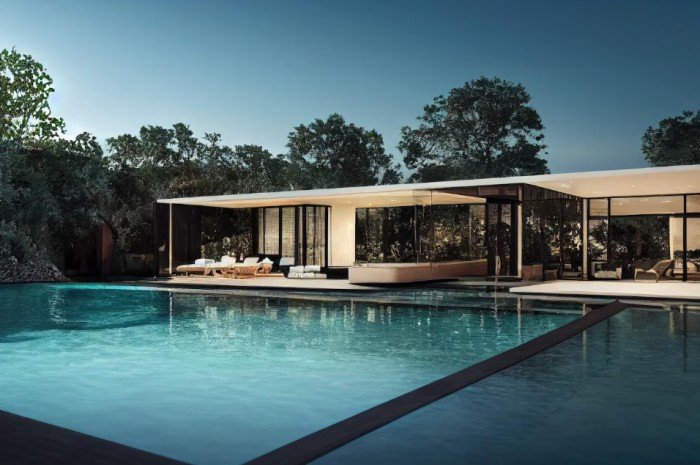Exterior home renderings have gained momentum in the real estate industry. The market was valued at an impressive $1.8 billion in 2020. Since the outer appearance of a house is the first thing people notice, leveraging the power of computer-generated imagery (CGI) helps viewers appreciate its curb appeal.
The technology can even be used for listings that have yet to be built or fully completed!
Read on to familiarize yourself with 3D exterior visualization, how combining it with landscape rendering takes your presentation to the next level, and how it compares with interior renders, courtesy of PlusRender.
What Are Exterior Home Renderings?
Exterior home renderings involve creating photorealistic 3D images to visually represent how the project’s exterior would look once built.
In addition, 3D exterior design focuses on showcasing the structure from several important angles and with great attention to detail. Hence, it can allow users to bring their visions to life while correcting any mistakes early on. This makes it easy to adapt the design according to client expectations and avoid expensive mistakes during development.
Types of 3D Exterior Visualizations
3D exteriors realistically depict how a particular space can be developed to provide a comprehensive understanding of the residential rendering project.
This can be done in two ways:
- Static images
- Dynamic animations
You can determine which to use by evaluating the scope of your architectural project.
The immersive quality of your rendered 3D exteriors can be further improved by playing around with different settings and environments to highlight your design’s best features. Here’s a look at different elements you can incorporate.
- Harness the power of the sun: Show the space on a warm, sunny day to produce a spectacular render that highlights the colors and materials used.
- Let it rain: Bad weather can be good for business. Create contrast with cloudy skies and cozy lighting on the inside to evoke an inviting atmosphere.
- Visualize nighttime: The glow of twilight is a great way to show off an exterior lighting system. You can even give viewers a glimpse of the interior from the windows to make the rendering look more spectacular and interesting.
- Sunrise and sunset: These periods generate eye-catching atmospheric lighting that you can use to produce an enchanting ambiance.
For the best results, pair it with landscape rendering.
Exterior Renderings With Landscape Renderings: A Better Way To Create Exterior Home Renderings
Most people believe exterior and landscape renderings are the same thing with different names, but that isn’t true.
Exterior visualizations involve different settings, weather conditions, lighting, materials, and textures, with an overall focus on how the external structure will look.
Meanwhile, landscape renderings consider the area around the house—the greenery, garden wall, animals, cars, people, patio, pedestrian paths, etc. They convey how the natural world will complement its architectural and residential surroundings. The house is still depicted but it isn’t the focal point.
When used together, stakeholders can employ storyselling—weaving character, depth, and personality into an inanimate structure that arouses the viewer’s emotions.
While these images are highly detailed, they mustn’t look too perfect.
Don’t Focus on Perfection
This is pretty much the standard in the rendering world and there’s a good reason for it. The real world isn’t perfect and your render shouldn’t be either. Renders strive for the greatest possible degree of realism to appeal to the human imagination but too much symmetry can make it look unnatural.
Instead, we show the perfection in imperfections to convince the viewer of the render’s realism. Think dust on cars, slight signs of wear and tear on the walkway, doors left half-open, scratches on the mailbox, terrain erosion, growth of lichen, etc. These small touches make the render appear lively, credible, and realistic.
How Do Exterior Home Renderings Differ From Interior Renderings? A Look at Their Defining Features
Interior renderings show the inside of a home. They highlight floor plans and show the location of structural components and furniture, including the materials used and how interior elements might appear under different lighting.
It is very different from exterior renderings that focus on the outside.
But the process of creating them is similar. Both require an artistic approach to simulating the design. They employ:
- Different materials to highlight a variety of details and settings
- Applying the right type of lighting (natural or artificial) from different angles to create the best reflections
- Using different camera angles and settings to give visual context
- Personalizing the design and adding nuances to tailor it to the clients’ tastes
The one thing that sets the two apart is landscape architecture. With exterior renderings, you have to consider how a structure’s surroundings influence how it looks.
If it’s in the countryside, you can show it in different seasons by tweaking the color of the leaves and using different flowers to give it a warm feeling. If the house has a roof terrace, you can employ an aerial view.
Why Should You Use Exterior Home Renderings?
Once upon a time, two-dimensional sketches were the industry standard. They contained all the information that construction companies needed to execute the design.
However, it also came with notable limitations. Sure, you could manipulate texture and lighting with sketches and estimate the relationship of an object with its surroundings, but guesstimating increased the likelihood of errors.
Additionally, they were often dull, monotonous, and difficult for laymen to understand.
In this regard, three-dimensional renderings have proven to be superior to flat 2D designs. Visually impressive exterior home rendering offers many benefits.
Better Alignment and Communication
Despite all the information blueprints contain, they’re still 2D representations of different structures. 3D renders are more similar to the actual results because they take into account how projects will look from different angles. They also depict the different materials, lighting, environments, and more.
This is a huge benefit in terms of alignment and communication. Construction teams can have a better overview of what the final structure will look like. Buyers can appreciate how it complements the surroundings. Architects and designers can more closely create their designs according to their vision. And real estate agents can have an easier time showing clients what they’re selling.
Customization and Adaptability
Creating renders is a multi-step process. The first step is always to construct a 3D model. After this model has been digitally recreated, renderers can then add various elements like lighting, special effects, materials, textures, and other elements.
Though it entails a lot of work, it offers an important benefit: easy customization and adaptability. When a design needs tweaking, it’s possible to simply change specific details instead of starting over with a fresh blueprint or sketch. This ensures that a design can be changed countless times without affecting the other elements.
Creates a Strong Emotional Appeal
Exterior renderings allow you to use sensory details to transform a house into a home. It uses mood lighting, scenery, and textures to stage the structure based on the feelings clients want to experience when they live in the house of their dreams, allowing you to leverage emotional marketing.
By using different visual cues, developers and agents can evoke different emotions and encourage buy-in. They can make homes look cozy and inviting. Office buildings can look state-of-the-art, sophisticated, and modern. Industrial areas can highlight accessibility and green surroundings.
Exterior renderings allow you to draw in your stakeholders by appealing to their needs and emotions.
Advertising Advantage
3D exterior renderings can help you market the houses you build with online and offline advertising. High-quality photorealistic renderings go deep into the details, highlighting all the little touches that make a big impact and grab the attention of buyers.
Exterior renderings can also be easily shared across online channels. They can be uploaded on social media and on websites, making geographic boundaries and time zones immaterial.
They can even be used for in-person events like roadshows and open houses. Instead of having everything printed out in a two-dimensional flyer, a 3D exterior render is easy to send and upload. It’s also a more engaging way to show what you’re offering.
Environmentally Friendly
The real estate industry has traditionally been heavily reliant on paper products for marketing. Flyers, posters, and banners accompany pop-up booths in malls, roadshows, and sales pitches.
Manufacturing paper contributes to deforestation and requires huge amounts of energy and water. It also leads to air pollution and waste. According to the World Counts, paper products constitute 26% of waste in landfills.
Switching to video content or campaigns that are delivered through Wi-Fi can reduce emissions by 50% to 70%.
Exterior renders are not only more engaging, easier to understand, and customizable, but they’re also better for our environment. Additionally, marketing yourself as a professional or company that advocates sustainability is a great way to stand out and show that you’re a responsible global citizen who isn’t purely profit-oriented. It demonstrates that you care about the Earth and our impact on it.
Plus Render Creates Breathtaking Exterior Renders
Enjoy the benefits of exterior renders with a trusted name in the industry: Plus Render. With over 14 years of experience in the architectural visualization industry, we create quality, highly realistic, and immersive exterior renders that meet your needs.







